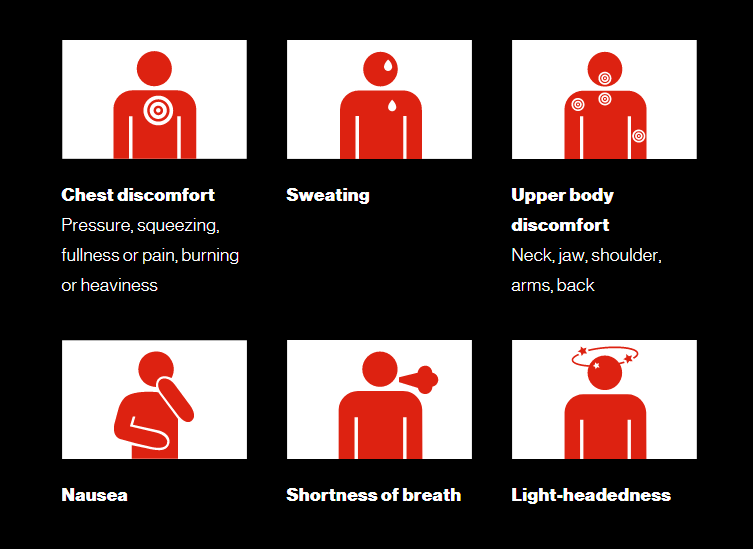What is a heart attack?
A heart attack occurs when blood flow to a section of the heart becomes blocked and the heart muscle can’t get oxygen. If the blood flow isn’t restored quickly, that section of the heart begins to die. Depending on how long the blood supply is cut off, the damage can be mild, severe or cause lifelong problems. In some cases a heart attack can be fatal.
Types of heart attack
Heart attacks can be divided into 2 types.
- STEMI (ST-elevation myocardial infarction)
- This is the complete blockage of blood flow in a coronary artery supplying the heart with oxygen-rich blood.
- Because of the complete loss of blood flow, the full thickness of the heart muscle supplied by that artery may die.
- This causes a change on the ECG (electrocardiogram). The ECG will show ST-elevation corresponding to the location of the damage to the heart wall.
- Non-STEMI (Non-ST-elevation myocardial infarction)
- This is the partial blockage of blood flow in a major coronary artery supplying the heart with oxygen-rich blood.
- Only part of the heart wall thickness is damaged, and no ST-elevation is present on an ECG.
Signs of a heart attack

Chest pain or discomfort is the most common symptom of a heart attack in both men and women. However:
- The symptoms may not always be sudden or severe.
- Some people do not experience any chest pain.
- Some people only have mild chest pain or discomfort.
- Some people only experience one symptom.
- Other people may have a combination of symptoms.
If you experience any of these signs of a heart attack:
- CALL 9-1-1 or your local emergency number immediately.
- Stop all activity. Sit or lie down, in whatever position is most comfortable.
- Take your nitroglycerin. If you take nitroglycerin, take your normal dosage.
- Chew and swallow ASA (Aspirin), if you are not allergic or intolerant – either one 325 mg tablet or two 81 mg tablets.
- ASA can help by stopping the blood clot that is causing the heart attack from getting any bigger.
- Do not take other pain medications such as Tylenol (acetaminophen) or Advil (ibuprofen) instead of ASA.
- Do not substitute ASA for medical care. Call 9-1-1 or your local emergency number first.
- Rest and wait. Stay calm while waiting for help to arrive.
- Keep a list of your medications in your wallet and by the phone. Emergency personnel will want this information.
Signs for men and women
Women generally recognize the “Hollywood heart attack” with chest-clutching, crushing pain. If their pain is less severe, or if they have non-pain signs such as nausea, sudden fatigue or shortness of breath (signs more often reported by women), they are more likely to delay getting to emergency care, and once there, they are less likely to get fast, aggressive treatment.
Who is at risk?
Risk factors for heart attack are conditions or habits that make it more likely that you will get heart disease. Coronary artery disease (CAD) is the most common form of heart disease. Some of the risk factors for CAD can be controlled and others cannot.
Risk factors you can control:
- smoking
- high blood pressure (hypertension)
- high cholesterol and triglyceride levels
- unhealthy weight
- diabetes
- metabolic syndrome – a combination of unhealthy weight, high blood pressure and high blood sugar.
- not enough exercise
- stress
- recreational drug use – drugs such as cocaine or amphetamines can trigger a spasm of your coronary arteries that can cause a heart attack.
Risk factors you cannot control:
- Age – the older you are, the higher your risk of a heart attack.
- Family history – if you have a close relative who has heart disease at an early age, you are at an increased risk.
- Medical history - autoimmune conditions such as rheumatoid arthritis or lupus can increase your risk of heart attack. Women who have had pre-eclampsia during pregnancy also have an increased risk.
- Indigenous heritage – First Nations, Metis and Inuit peoples have a higher risk of heart disease and stroke than the general population. This is because they are more likely to have high blood pressure and diabetes.
- South Asian and African heritage – people of African or South Asian heritage are more likely to have high blood pressure, diabetes or other risk factors at a younger age.
- Personal circumstances and environmental factors – access to healthy food, safe drinking water, health services and social services all have an influence on your health.
Causes
Most commonly, a heart attack happens when blood flow through one or more of the coronary arteries is blocked. This stops oxygen from reaching parts of the heart.
The most common cause of blocked blood flow is narrowing and hardening of the arteries (atherosclerosis).
- Atherosclerosis is the buildup of cholesterol plaque on the inside wall of an artery.
- The buildup of plaque causes the arteries to harden.
- Over time, the artery can narrow or become blocked.
- A plaque can also burst open, causing surrounding blood to clot around it.
- Blood clots can become so large that they can also block blood flow through the artery to the heart, causing a heart attack.
Heart attacks can also be caused by a coronary artery spasm.
- A spasm causes a temporary tightening of a coronary artery.
- The tightening can stop blood flow through the artery.
- Some recreational drugs can cause a life-threatening spasm.
- Often, the causes of spasms are not known.
Difference between heart attack and cardiac arrest
People often think a heart attack and cardiac arrest are two names for the same thing. They are not. A heart attack can lead to cardiac arrest, but they are two different conditions.
Heart attack
- The heart is still beating.
- Blood is still flowing in the body.
- The person is still alive.
Cardiac arrest
- The heart has stopped beating.
- Blood has stopped flowing.
- The person is unconscious.
- Not breathing normally or making gasping sounds.
A heart attack needs immediate medical attention but doesn’t need CPR. If a heart attack leads to a cardiac arrest, it is a critical medical emergency that requires immediate intervention – CPR and an AED.

Donna & Barry both beat heart disease.

Difference between heart attack and angina
Angina is the medical term for chest pain or discomfort caused by a temporary disruption in the flow of blood and oxygen to the heart. It is not a heart attack. Angina pain usually goes away with rest or medication. It is also a warning sign that you are at increased risk for heart attack or cardiac arrest.
Diagnosis
Your doctor will diagnose a heart attack after reviewing your symptoms, taking a medical history and giving you a complete physical exam. Tests for a heart attack may include:
- ECG/EKG (electrocardiogram)
- Measures your heart’s electrical activity to tell if you are having a heart attack or if you have had one recently.
- Can be used to monitor your recovery from a heart attack, the progression of your heart disease, and the effectiveness of your heart medications or pacemaker.
- blood tests
- Can identify tell-tale proteins (troponins) that the heart releases into the bloodstream during a heart attack.
- chest x-ray
- echocardiogram
- cardiac catheterization
- cardiac CT (cardiac computerized tomography)
- heart MRI (magnetic resonance imaging)
Treatment
Early treatment for a heart attack can prevent or limit damage to the heart muscle.
Act fast by calling 9–1–1 at the first symptoms of a heart attack. Emergency treatment can begin in the ambulance on the way to the hospital.
Treatment for a heart attack may include medication, surgery and lifestyle changes. You and your doctor will discuss the treatment options and decide which is best for you and your circumstances.
Medication
Medications used to treat heart attack include:
- ASA (Aspirin) and other antiplatelet agents
- thrombolytics – clot-busting drugs
- blood thinners (anticoagulants)
- nitroglycerin
- beta blockers
- ACE inhibitors
- pain relievers
- statins
Surgery and other procedures
Surgical options to improve blood flow to your heart may include:
- percutaneous coronary intervention (PCI) (coronary angioplasty with stent)
- coronary artery bypass graft surgery (CABG)
Lifestyle
You can lower your risk of developing other heart diseases and stroke by knowing and controlling your blood pressure, diabetes and blood cholesterol. It is also important to lead a healthy lifestyle.
- Be smoke-free.
- Be more active.
- Eat a healthy balanced diet.
- Aim for a healthy weight – there are some specific diets you can follow that have been proven to reduce the risk of heart disease.
- Drink less alcohol.
- Manage stress.
Talk to your doctor about the lifestyle changes that will benefit you the most.
Recovery
Cardiac rehab is a personalised program of exercise, education and counselling to help you recover from a heart attack. Rehab will help you regain your strength and reduce your risk of having other heart problems in the future. Talk to your doctor about how to find a program in your area or contact your public health department or hospital.
A heart attack can increase your risk of developing heart failure, where your heart muscle isn’t strong enough to pump enough blood through your body. That’s why it is important to be aware of your symptoms and report any changes in your health to your healthcare team.
Related information
Living Well with Heart Disease
Watch this video of Esther describing her personal journey of the spirit and mind during her heart transplant surgery.
